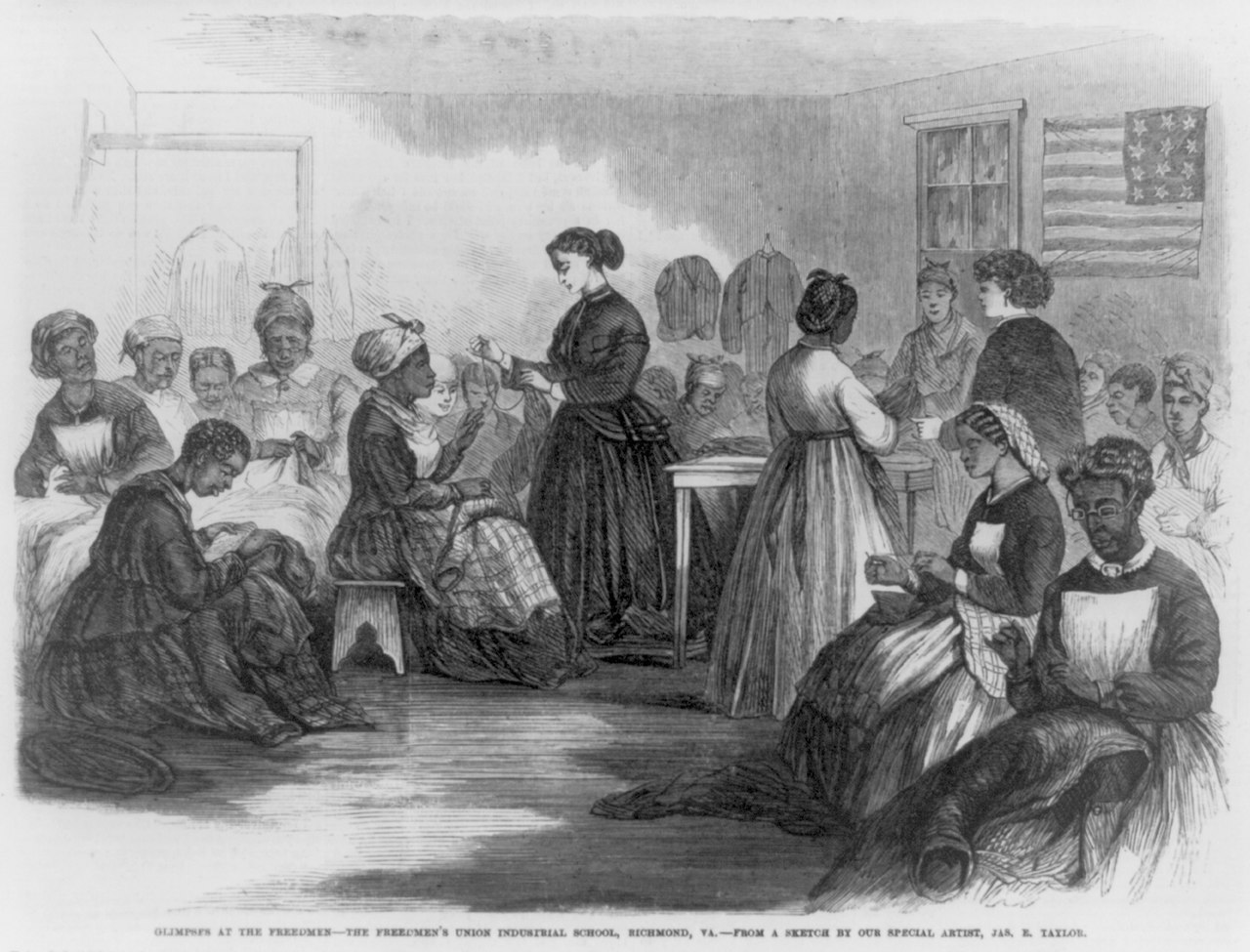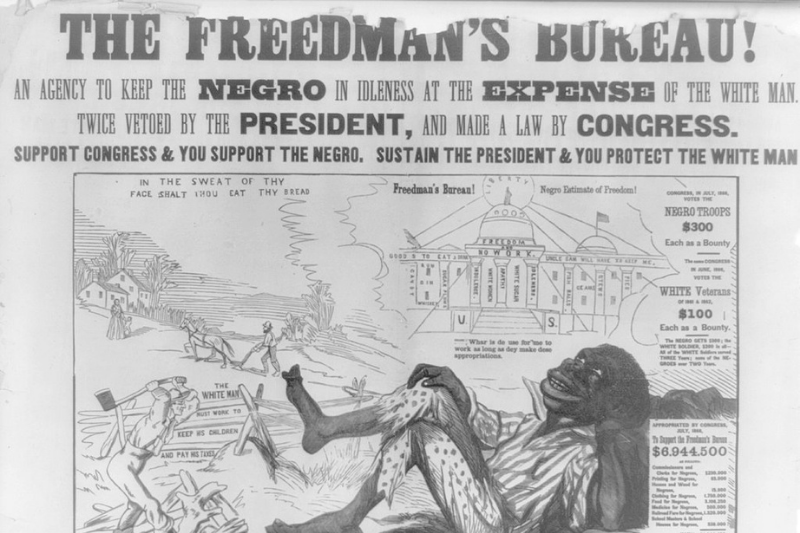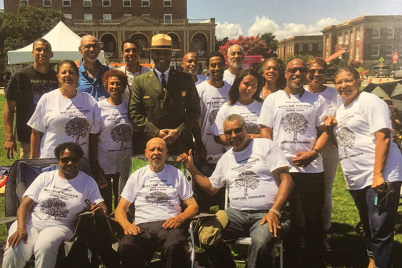The debate over Reconstruction and the Freedmen’s Bureau was nationwide. This 1866 Pennsylvania election poster alleged that the Bureau kept the Negro in idleness at the hard-working white taxpayer’s expense. A racist caricature of a Black man is depicted.
BY JACQUELINE HUBBARD, ESQ., ASALH, President
According to a study done by the Equal Justice Initiative in Montgomery, Ala., there is an enduring legacy of racial violence against Black Americans, resulting in 4,400 racial terror lynchings between 1877 (the end of Reconstruction) and 1950.
The Civil Rights Movement, beginning in the 1950s and culminating in the 1970s, ended these brutal tactics by the civilian population. It shifted its form but remained ever vigilant and violent.
By the mid-1990s, particularly after the invasion of illegal drugs and easy access to guns in Black and poor communities and the subsequent draconian criminal laws, the scourge of mass incarceration of Black men, women, and children began in earnest.
The Civil War ended in 1865, but the war for Black freedom did not end so soon. There was continued resistance to the Union Army and violent opposition to Black voting rights by angry and impoverished former Confederates.
The death, destruction, violence, and terror against the newly freed were unparalleled in United States history. By 1868, the Union was compelled to occupy the South to prevent the slaughter of newly freed Black people.
President Ulysses S. Grant spent a great deal of time seeking passage of the Civil War and Reconstruction Amendments during his first term. He stopped the Ku Klux Klan with a great deal of success.
However, ensuring voting rights for Black Americans in the southern states was a tough fight that continued throughout Reconstruction and afterward.
For the first time after 1868, Constitutional Amendments were passed giving the rights to vote, due process, and to equal protection under the law for Black men. During Reconstruction, the 13th (1865), 14th (1868), and 15th Amendments (1868) to the United States Constitution were adopted, pressed by Congress and the president.
These Amendments are often called the “Civil War Amendments” or the “Reconstruction Amendments.” For the first time in American history, people who had participated in the Confederate insurrection, primarily white, were denied the right to vote.
The 14th Amendment, Section 2, denied the right to vote to any male who participated in the rebellion. Section 3 forbade the election of any senator or representative in Congress to hold any elected office if they engaged in insurrection or rebellion.
This complete reversal of the status quo was met by unadulterated hatred, resistance, and violence by the defeated Confederates. As a result, President Grant had to send thousands of Union troops to the South to protect the enfranchisement of Black people and keep the polling places open.
Black people were met with anger, violence, and hatred at every attempt to vote. Yet, vote they did, and Reconstruction lasted until nearly 1877, with many African American accomplishments.
Many northerners came South to help open schools, and with the education of Black people, education was vitally important. Union Troops protected the Freedmen’s Bureau, banking institutions, and voting places, which enflamed and enraged the South, yet greatly aided the newly emancipated.

Northern teachers traveled into the South to provide education and training for the newly freed population.
Until W.E.B. DuBois’ seminal work, “Black Reconstruction in America 1860-1880, there had been one prevailing view of the effects of Reconstruction. For decades, white intellectuals held that nothing was accomplished by the newly freed except confusion and corruption led by ignorant Black politicians.
DuBois’ research, first revealed in his doctoral dissertation at Harvard University, proved this view to be incorrect. In fact, Black Americans miraculously achieved a great deal during Reconstruction. Undoubtedly, the presence of Union troops helped keep the peace.
For the first time, Black Americans could and did vote, held state constitutional conventions, wrote fair and just laws, and elected a governor, United States Senators and Representatives, and other elected officials. Black businesses began, farming for themselves started, and Black communities began to flourish.
Black voters were uniformly Union supporters or Republicans, while former Confederates and their supporters were encapsulated in the Democratic party. After several years, southern resistance to Reconstruction continued to be fierce, and northerners began to tire of it.
Support for Reconstruction began to wane before the end of President Grant’s second term. By 1876, his last year in office, uniform support for the newly emancipated had greatly weakened.
In the presidential election of 1876, a compromise was entered into by Republicans and Democrats that resulted in the election of Republican Rutherford B. Hayes. Historian Eric Foner wrote in “Reconstruction: America’s Unfinished Revolution, 1863-1877” that “neither the humanitarian impulse that had helped create the Republican party nor the commitment to equal citizenship that evolved during the war and Reconstruction, entirely disappeared.”
The compromise that ended Reconstruction took place along the following facts. Many southerners opposed Grant, the outgoing Republican president, and Rutherford B. Hayes, the 1876 Republican presidential candidate. In contests in four Southern states, Hayes won the presidency by one electoral vote.
A deal had to be made, and it was. In return for southern support of Hayes, Republicans agreed to support the withdrawal of federal troops from the former Confederate states, formally ending Reconstruction.
This was the Compromise of 1877. South Carolina, Florida, and Louisiana agreed to certify Rutherford B. Hayes as the president in exchange for removing federal troops from the South. Hayes complied with the compromise.
He quickly ended Reconstruction and withdrew federal troops from the last two occupied states, South Carolina and Louisiana. The right to vote was the first victim of the ensuing assault on Constitutional rights for African Americans, which continues today. Jim Crow and widespread violence against Blacks ensued, including brutal lynchings for minor or imagined social infractions.
The compromise resulted in an appropriations bill for the army, which included the prohibition of any state’s military occupation by the United States Army. By the 1878 election, Congress was dominated by the Democratic Party, and it passed the Posse Comitatus Act in 1878 to prohibit any future president or Congress from directing, by military order or federal legislation, the imposition of federal troops in any U.S. state.
Popular historian Ron Chernow wrote in “Grant” that once Reconstruction disintegrated, “it left southern blacks for eighty years at the mercy of Jim Crow segregation, lynchings, poll taxes, literacy tests, and other tactics designed to segregate them from whites and deny them the vote.”

Jacqueline Hubbard, Esq.
Attorney Jacqueline Hubbard graduated from the Boston University Law School. She is currently the president of the St. Petersburg Branch of the Association for the Study of African American Life and History, Inc.









